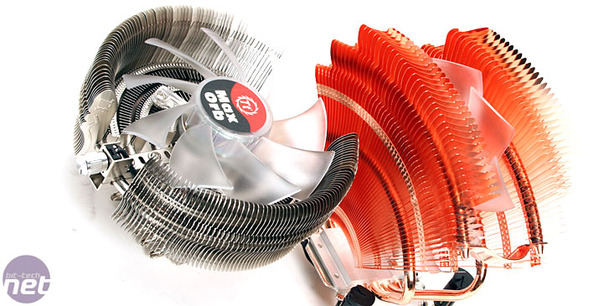
How We Tested:
In order to establish how well each of these heatsinks performed, we set up a worst-case scenario using one of the hottest-running processors ever released. Intel’s Pentium Extreme Edition 955 is a dual-core chip that is based on the 65 nanometre Presler core (two Cedar Mill dies on the same chip package). It runs at a lofty 3.46GHz and, according to Intel, the chip has a TDP of 130W – that’s the same TDP as Intel’s current flagship Core 2 Extreme QX6700 quad-core processor.We installed the processor in an MSI P6N SLI Platinum motherboard with a passively cooled Sapphire Radeon X1600 Pro and 1GB of Corsair memory. We recently changed the motherboard after our original Asus P5WD2-E went up to visit the silicon gods and never returned. MSI’s P6N SLI Platinum was chosen because of its fairly typical heatpipe design and layout that is employed on many of the top motherboards in this day and age.
In addition to testing the cooler on MSI’s P6N SLI Platinum, there were many more motherboards on hand in the bit-tech offices, should we have a cooler that is overly large and could cause problems on certain motherboards.
Our Pentium XE 955’s heatspreader was lapped because we found that the contact in the centre was incredibly poor and sometimes resulted in system instabilities when heavily loaded at high temperatures. We used a quick-curing ‘Lumière’ thermal paste from Arctic Silver with all of the heatsinks, except for those that come with pre-applied thermal interface material.

Temperature Measurement:
For measuring the CPU temperature, we recorded the temperatures using the on-board sensors via MSI’s PC Alert system monitoring software. In addition, we also recorded PWM and ambient temperatures using a Maplin 501 K-type digital thermometer. This is accurate to 0.1°C between -50°C and 1000°C.The ambient temperature was taken at a fixed position, one metre away from the system. Our offices are temperature controlled, so we tried our best to keep the environment as constant as possible. With this in mind, our office air conditioning was set to a constant 26°C during testing.
Software & Configuration:
Our load scenario came in the form of Orthos, which was set to load both CPU cores (HyperThreading was disabled) using a large in-place FFT calculation. Finally, in order to make sure the CPU wasn't throttling, we used RMClock to monitor the processor's power states.Once the heatsink was installed and the temperature probes were set up, we set the system up ready for loading. At this point, we loaded the two processing cores with Orthos and unplugged the CPU fan. This allowed us to reach higher temperatures much faster in order to find out a heatsink's maximum load temperature.
Using this methodology, we plugged the fan back in as soon as the CPU temperature reached 70°C and then waited for the temperature curve to level off. After around 15 minutes of Orthos load with the fan plugged in, we then recorded the ambient temperature, PWM temperature and then finally the CPU temperature. At this point, the load was then removed and the CPU temperature was left to settle down. Once the CPU temperature had stabilised, we recorded the ambient temperature, PWM temperature and then the CPU temperature to give us our idle readings.
In order to ensure that our results were as accurate as possible, we ran all of our tests three times with each of the heatsinks. This process included completely removing the heatsink from the board before reinstalling it again (we also reapplied the TIM if it wasn't pre-applied).

MSI MPG Velox 100R Chassis Review
October 14 2021 | 15:04








Want to comment? Please log in.